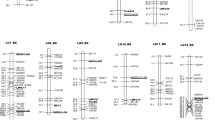Abstract
Two F2 populations of cotton (Gossypium hirsutum L.) from the crosses of HS46 x MARCABUCAG8US-1-88 (MAR) and HS46 x Pee Dee 5363 (PD5363) were characterized for restriction fragment length polymorphisms (RFLPs) using DNA probes. Seventy-three probe/enzyme combinations were used in the HS46 x MAR population analysis, which resulted in 42 informative polymorphic fragments. These 42 moleclar markers represented 26 polymorphic loci, which consisted of 15 codominant and 11 dominant (+/-) genotypes. Chi-square analyses of these loci fit expected genotypic ratios of 1∶2∶1 and 3∶1, respectively An analysis of these loci with the MAPMAKER program resulted in the establishment of four linkage groups A, B, C, and D with 4,2,2, and 2 loci, respectively, as well as 16 unlinked loci. Six probe-enzyme combinations were assayed on the HS46 x PD5363 population, which resulted in 11 informative polymorphic fragments. These 11 fragments represented 6 polymorphic loci, 1 dominant (+/-) and 5 codominant genotypes. The MAPMAKER analysis of these loci yielded 2 linked loci. Thus, a total of 53 polymorphic fragments and 32 polymorphic loci, representing five linkage groups, were identified among the two families.
Similar content being viewed by others
References
Ausbel F (ed) (1987) Current protocols in molecular biology. Greene Publ, New York
Aviv H, Leder P (1972) Purification of biologically active globin messenger RNA by chromatography on oligothymidylic acidcellulose. Proc Natl Acad Sci USA 69:1408–1412
Budowle B, Baechtel FS (1990) Modifications to improve the effectiveness of restriction fragment polymorphism typing. Appl Theor Electrophoresis 1:181–187
Cantrell RG, Davis DD (1993) Characterization of hirsutum x barbadense breeding lines using molecular markers. In: Herber D (ed) Proc Beltwide Cotton Prod Res Conf. Natl Cotton Council Am, Memphis, Tenn., pp 1551–1553
Feinberg AP, Vogelstein B (1983) A technique for radiolabelling DNA restriction endonuclease fragments to high specific activity. Anal Biochem 137:266–267
Green CC, Culp TW, Kittrell BU (1990) Notice to plant breeders and geneticists relative to release of two cotton germplasm lines. SC Agric Exp Stn Germplasm Release
Gubler U, Hoffman BJ (1983) A simple and very efficient method for generating cDNA libraries. Gene 25:263–269
Haldane JBS, Smith CAB (1947) A new estimate of the linkage between the genes for color-blindness and hemophilia in man. Ann Eugenics 14:10–31
Hanahan D (1983) Studies on transformation of Escherichia coli with plasmids. J Mol Biol 166:557–580
Lander ES, Green P (1987) Construction of multi-locus linkage maps in humans. Proc Natl Acad Sci USA 84:2363–2367
Lander ES, Green P, Abrahamson J, Barlow A, Daly MJ, Lincoln SE, Newburg L (1989) MAPMAKER: an interactive computer package for constructing primary linkage maps of experimental and natural populations. Genomics 1:174–181
MacDonald RJ, Swift GH, Przybyla AE, Chirgwin JM (1987) Isolation of RNA using guanidinium salts. In: Berger SL, Kimmel AR (eds) Guide to molecular cloning techniques. Methods Enzymol 152:219–223
MAPMAKER (1993) MAPMAKER/EXP 3.0 Beta release “3.0b”. anuary 1993. Whitehead Institute, Cambridge, Mass.
Mather K(1957) The measurement of linkage in heredity. John Wiley and Sons, New York
Melchinger AE, Messmer MM, Lee M, Woodman WL, Lamkey KR (1991) Diversity and relationships among U.S. maize inbreds revealed by restriction fragment length polymorphisms. Crop Sci 31:669–678
Meredith WR Jr (1992) RFLP association with varietal origin and heterosis. In: Herber D (ed) Proc Beltwide Cotton Prod Res Conf. Natl Cotton Council Am, Memphis, Tenn., p 607
Morton NE (1955) Sequential tests for the detection of linkage. Am J Hum Genet 7:277–318
Morton NE, MacLean CJ, Lew R, Yee S (1986) Multipoint linkage analysis. Am J Hum Genet 38:868–883
Patterson AH (1993) Molecular markers in cotton improvement. In: Herber D (ed) Proc Beltwide Cotton Prod Res Conf. Natl Cotton Council Am. Memphis, Tenn., p 1557
Reinisch MJ,Dong J, Bruaker CL, Stelly DM, Wendel JF, Patterson AH (1994) A detailed RFLP map of cotton, Gossypium hirsutum x Gossypium barbadense: chromosome organization and evolution in a disomic polyploid genome. Genetics 138:829–847
Saki RK, Gelfand DH, Stoffel S, Scharf SJ, Higuchi R, Horn GT, Mullis KB, Erlich HA (1988) Primer-directed enzymatic amplification of DNA with a thermostable DNA polymerase. Science 239:487–491
Shappley ZW (1994) Restriction fragment length polymorphisms in cotton (Gossypium hirsutum L.): feasibility of use, diversity among plants within a line, and establishment of molecular markers and linkage groups among two F2 populations. MSc thesis, Mississippi State University, Mississippi State, Miss.
Shappley ZW, Jenkins JN, McCarty JC Jr (1993) Potential for RFLP mapping in cotton. In: Herber D (ed) Proc Beltwide Cotton Prod Res Conf. Natl Cotton Council Am, Memphis, Tenn., p 610
Skorupska HT, Shoemaker RC, Warner A, Shipe ER, Bridges WC (1993) Restriction fragment length polymorphism in soybean germplasm of the southern USA. Crop Sci 33:1169–1176
Stelly DM (1993) Interfacing cytogenetics with the cotton genome mapping effort. In: Herber D (ed) Proc Beltwide Cotton Prod Res Conf. Natl Cotton Council Am, Memphis, Tenn., pp 1545–1550
Wang G, Kowalski S, Altman DB, El-Zik KM, Fryxell PA, Kohel RJ, Smith CW, Thaxton P, Wing RA, Patterson AH (1993) Introgression of agriculturally valuable QTLs from wide crosses in cotton using DNA markers. In: Herber D (ed) Proc Beltwide Cotton Prod Res Conf. Natl Cotton Council Am, Memphis, Tenn., p 1558
Wing RA (1993) Prospects for physical mapping and map-based cloning of agriculturally important genes in cotton. In: Herber D (ed) Proc Beltwide Cotton Prod Res Conf. Natl Cotton Council Am, Memphis, Tenn., 1557
Author information
Authors and Affiliations
Additional information
Communicated by G. Wenzel
Contribution of the USDA-ARS in cooperation with the Miss Agric For Exp Stn.
Rights and permissions
About this article
Cite this article
Shappley, Z.W., Jenkins, J.N., Watson, C.E. et al. Establishment of molecular markers and linkage groups in two F2 populations of Upland cotton. Theoret. Appl. Genetics 92, 915–919 (1996). https://doi.org/10.1007/BF00224030
Received:
Accepted:
Issue Date:
DOI: https://doi.org/10.1007/BF00224030




